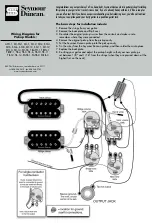
1
Introduction
Thank you for purchasing the Electronic Audio Experiments Hypersleep. This manual is an
in-depth guide for properly understanding and enjoying your pedal. Below is a bit of context
for how Hypersleep came to be. If you would like to skip forward to how the pedal works,
begin reading at the Operation section on the next page.
Hypersleep is an analog, solid-state reverberator constructed around the unusual and
obsolete MN3011 bucket brigade device (BBD). The BBD reverbs of the mid 80s were panned
as unnatural, metallic, and low-fidelity. Indeed, they sound little like a typical room, spring,
or plate; as such, they were quickly overtaken by far more flexible digital signal processors
that algorithmically emulated these physical structures. Like so many science fiction works
of the era, MN3011 reverb was a vision of the future that never came to pass.
After falling in love with a particularly spaced-out prototype of the EHX Solid State Re-
verb, a particular MN3011 design relegated to the dustbin of stompbox history, I decided to
create my own take on BBD reverb from scratch. I started with my own preamplification
and filter blocks in order to ensure low noise and musical handling of high amplitude input
signals. Other improvements were purely utilitarian, such as a sturdy regulated boost con-
verter supply and an embedded microcontroller clock. Both offer substantial improvements
in the noise floor and sound quality compared to vintage designs while still retaining the
uniqueness of the MN3011. However, the most notable departure from vintage BBD reverb
effects is the addition of an LFO to modulate the delay time. This is a common feature in
analog delays and BBD chorus units, but the effect is strikingly different when applied to a
complex multi-tapped reverb output.
Hypersleep was a labor of love over two years in the making. I owe special thanks to
Scott McCombs for his work on the embedded microcontroller code, Jon Ashley from Bondi
Effects for his useful insights about digital clocks, Rick “Hawker” Shaich for his endless
wisdom regarding BBDs, Mike Moschetto and Donovan Ford for being early beta testers,
and finally to Dan “Danger” Niejadlik for sharing with me the bizarre EHX prototype that
started me down this path.
And, a brief note on Version 2: once we realized just how limited the MN3011 supply
was, we made a second pass at the design to make it as good as we possibly could. The
biggest change was improved filtering, for a brigher reverberation with more overtones and
clarity.
I am extremely proud of Hypersleep and hope you enjoy it. Thanks for reading!
-John Snyder, EAE
PS—the artwork for the Hypersleep pays homage to the Voyager Golden Record, with a
little extra influence from the game Lunar Lander. (Thanks to Zach for his fantastic inter-
pretations of both.)
1
























